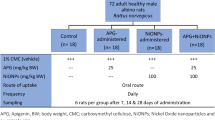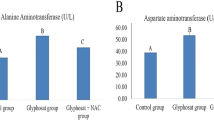Abstract
The present study investigates the prophylactic effect of Nymphaea alba against ferric nitrilotriacetate (Fe-NTA)-induced renal oxidative stress, hyperproliferative response and renal carcinogenesis in Wistar rats. Treatment with Fe-NTA (9 mg Fe/kg body weight, intraperitoneally) enhanced iron-ascorbate-induced renal lipid peroxidation, xanthine oxidase, γ-glutamyl transpeptidase and hydrogen peroxide (H2O2) generation with reduction in renal glutathione content, antioxidant enzymes, viz., glutathione peroxidase, glutathione reductase, catalase, glucose-6-phosphate dehydrogenase and phase-II metabolising enzymes such as glutathione-S-transferase and quinone reductase. It also elevated the levels of blood urea nitrogen, serum creatinine, ornithine decarboxylase (ODC) activity and thymidine [3H] incorporation into renal DNA. It also enhanced DEN-initiated renal carcinogenesis by increasing the percentage incidence of renal tumors. Treatment of rats orally with N. alba (100 and 200 mg/kg body weight) resulted in significant decrease in γ-glutamyl transpeptidase, lipid peroxidation, xanthine oxidase, H2O2 generation, blood urea nitrogen, serum creatinine, renal ODC activity, DNA synthesis (p ≤ 0.001) and incidence of tumors. Renal glutathione content (p ≤ 0.001), glutathione metabolizing enzymes (p ≤ 0.001) and antioxidant enzymes were also recovered to significant level (p ≤ 0.001). Thus, our results show that N. alba is a potent chemopreventive agent and suppresses Fe-NTA-induced oxidative stress, hyperproliferative response and renal carcinogenesis in Wistar rats. (Mol Cell Biochem 271: 1–11, 2005)
Similar content being viewed by others
Abbreviations
- AC:
-
adenocarcinoma
- CC:
-
cancerous cells
- DC:
-
dense chromatin
- DCT:
-
distal convoluted tubule
- G:
-
glomerulus
- HC:
-
hyperchromatism
- LIC:
-
leucocytic infiltatory cells
- NC:
-
necrosis
- NT:
-
necrotic tissue
- PM:
-
pools of mucin
- PT:
-
proximal convoluted tubule
- TC:
-
tumor cells
- TE:
-
tubular epithelium
References
Aruoma OI: Methodological considerations for characterizing potential antioxidant actions of bioactive components in plant foods. Mutat Res 523–524: 9–20, 2003
Block G: A role for antioxidants in reducing cancer risk. Nutr Rev 50: 207–213, 1992
Smith AG, Francis JE, Cathew P: Iron as a synergist for hepatocellular carcinoma induced by polychlorinated biphenyls in Ah-responsive C57BL/10ScSn mice. Carcinognesis 11: 437–444, 1990
Inoue S, Kawanishi S: Hydroxyl radical production and human DNA damage induced by ferric nitrilotriacetate and hydrogen peroxide. Cancer Res 47: 6522–6527, 1987
Anderson RL, Bishop WE, Campbell RL: A review of the environmental and mammalian toxicology of nitrilotriacetic acid. Crit Rev Toxicol 15: 1–102, 1985
Kawabata T, Ma Y, Yamador I, Okada S: Iron induced apoptosis in mouse renal proximal tubules after an injection of renal carcinogen, iron nitrilotriacetate. Carcinogenesis 18: 1389–1394, 1997
Hamazaki S, Okada S, Li JL: Oxygen reduction and lipid peroxidation by iron chelates with special reference to ferric nitrilotriacetate. Arch Biochem Biophys 272: 10–17, 1989
Tsao B, Curthoys NP: The absolute asymmetry of orientation of gamma glutamyl transpeptidase and amino-peptidase on the external surface of the rat renal brush border membrane. J Biol Chem 255: 7708–7711, 1980
Toyokuni S, Uchida K, Okamoto K, Hattori-Nakakuki Y, Hiai H, Stadtman ER: Formation of 4-hydroxy-2-nonenal modified proteins in the renal proximal tubules of rats treated with a renal carcinogen, ferric nitrilotriacetate. Proc Natl Acad Sci USA 91(7): 2616–2620, 1994
Khan N, Sharma S, Alam A, Saleem S, Sultana S: Tephrosia purpurea ameliorates N-diethylnitrosamine and potassium bromate-mediated renal oxidative stress and toxicity in Wistar rats. Pharmacol Toxicol 88: 294–299, 2001
Khan N, Sharma S, Sultana S: Nigella sativa ameliorates potassium bromate induced early events of carcinogenesis: Diminution of oxidative stress. Hum Exp Toxicol 22(4): 193–203, 2003
Khan N, Sharma S, Sultana S: Attenuation of potassium bromate-induced nephrotoxicity by coumarin (1,2-benzopyrone) in Wistar rats: Chemoprevention against free radical-mediated renal oxidative stress and tumor promotion response. Redox Rep 9(1): 19–28, 2004
Bhattacherjee SK: Handbook of Indian Medicinal Plants. Pointer Publishers, Jaipur, India, p. 22, 1998
Antonio A, Souza A, Brito RM: Oral anti-inflammatory and anti-ulcerogenic activities of a hydroalcoholic extract and partitioned fraction of Turnera ulmifolia (Turneaceae). J Ethnopharmacol 61: 215–228, 1988
Didry N, Duberwil L, Tratin F, Pinkas M: Antimicrobial activity of aerial parts of Drossera pelitata Smith on oral bacteria. J Ethnopharmacol 60: 215–228, 1988
Awai M, Narasaki M, Yamanoi Y, Seno S: Induction of diabetes in animals by parenteral administration of ferric nitrilotriacetate. A model of experimental hemochromatosis. Am J Pathol 95: 663–672, 1979
Jollow DJ, Mitchell JR, Zampaglione N, Gillette JR: Bromobenzene induced liver necrosis: Protective role of glutathione and evidence for 3,4-bromobezene oxide as the hepatotoxic metabolite. Pharmacol 11: 151, 1974
Wright JR, Colby HD, Miles PR: Cytosolic factors that affect microsomal lipid peroxidation in lung and liver. Arch Biochem Biophys 206: 296–304, 1981
Kanter MW: Clinical Chemistry. The Bobber Merill Company Inc., USA, p. 80, 1975
Hare RS: Endogenous creatinine in serum and urine. Proc Soc Exp Biol Med 74: 148, 1950
Pick A, Keisari Y: Superoxide anion and H2O2 production by chemically elicited peritoneal macrophages-induction by multiple non-phagocytic stimulus. Cell Immunol 59: 301–308, 1981
Habig WH, Pabst MJ, Jakoby WB: Glutathione-S-transferases: The first enzymatic step in mercapturic acid formation. J Biol Chem 249: 7130–7139, 1974
Carlberg I, Mannervik B: Glutathione level in rat brain. J Biol Chem 250: 4575–4480, 1975
Orlowski M, Meister A: γ-Glutamyl cyclotransferase distribution, isozymic forms and specificity. J Biol Chem 248: 2836–2844, 1973
Claiborne A: Catalase activity. In: R.A. Greenwald (ed). CRC Handbook of Methods in Oxygen Radical Research. CRC Press, Boca Raton, pp.~283–284, 1985
Mohandas M, Marshal JJ, Duggin GG, Horvath JS, Tiller D: Differential distribution of glutathione and glutathione related enzymes in rabbit kidney. Cancer Res 44: 5086–5091, 1984
Zaheer N, Tiwari KK, Krishnan PS: Exposure and solubilization of hepatic mitochondrial shunt dehydrogenases. Arch Biochem Biophys 109: 646–648, 1965
Athar M, Sharma SD, Iqbal M, Sultana S, Pandaya KB, Tripathi IP: Coordination of copper polyamines complex with immidiozoles potentiates its superoxide dismutase mimicking activity and abolishes its interactions with albumin. Biochem Mol Biol Int 39: 813–821, 1996
Benson AM, Hunkalar MJ, Talalay P: Increase of NADPH, quinone reductase activity by dietary antioxidant: Possible role in protection against carcinogenesis and toxicity. Proc Natl Acad Sci USA 77: 5116–5220, 1980
O’Brien TG, Simsiman RC, Boutwell RK: Induction of the polyamine biosynthetic enzymes in mouse epidermis by tumor promoting agents. Cancer Res 35: 1662–1670, 1975
Smart RC, Huang MT, Conney AH: Sn 1,2-diacylglycerols mimic the effects of TPA in vivo by inducing biochemical changes associated with tumor promotion in mouse epidermis. Carcinogenesis 7: 1865–1870, 1986
Giles KW, Myers A: An improved diphenyl method for the estimation of deoxyribonucleic acid. Nature 206: 93, 1965
Lowry OH, Rosebrough NJ, Farr A, Randall RJ: Protein measurement with the Folin phenol reagent. J Biol Chem 193: 265–275, 1951
Wattenberg LW: An overview of chemoprevention: Current status and future prospects. Proc Soc Exp Biol Med 216: 133–141, 1997
Chesson A, Collins A: Assessment of the role of diet in cancer prevention. Cancer Lett 237–245, 1997
Cerutti PA: Prooxidant states and tumor promotion. Science 227: 375–381, 1985
Jambor J, Skrzypczak L: Flavonoids from the flowers of Nymphaea alba L. Acta Societatis Botanicorum Polaniae 60(1–2): 119–125, 1991
Jambor J, Skrzypczak L: Phenolic acids from the flowers of Nymphaea alba L. Acta Societatis Botanicorum Polania 60(1–2): 127–132, 1991
Joshi V, Merchant JR, Nadkarny VV, Namboori KK, Vaghani DD: Chemical constituents of some Indian medicinal plants. Indian J Chem 12(2): 226, 1974
Recio MC, Rios JL, Villar A: A review of some antimicrobial compounds isolated from medicinal plants reported in the literature 1978–1988. Phytoth Res 3(4): 117–125, 1989
Akagi K, Hirose M, Hoshiya T, Mizoguchi Y, Ito N, Shirai T: Modulating effects of ellagic acid, vanillin and quercetin in a rat medium term multi-organ carcinogenesis model. Cancer Lett 94(1): 113–121, 1995
Nishino H, Naitoh E, Iwashima A, Umezawa K: Quercetin interacts with calmodulin, A calcium regulating protein. Experimentia 40: 184–188, 1984
De Flora S, Ramel C: Mechanism of inhibition of mutagenesis and carcinogenesis: Classification and overview. Mutat Res 202: 285–306, 1988
Pegg AE, Shantz LM, Colemn CS: Ornithine decarboxylase as a target for chemoprevention. J Biol Chem 22: 132–138, 1995
Author information
Authors and Affiliations
Corresponding author
Rights and permissions
About this article
Cite this article
Khan, N., Sultana, S. Anticarcinogenic effect of Nymphaea alba against oxidative damage, hyperproliferative response and renal carcinogenesis in Wistar rats. Mol Cell Biochem 271, 1–11 (2005). https://doi.org/10.1007/s11010-005-2258-2
Received:
Accepted:
Issue Date:
DOI: https://doi.org/10.1007/s11010-005-2258-2




